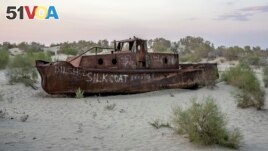Climate change is quickening the disappearance of the Aral Sea. Once a single body of water, the lake now exists in pieces in Kazakhstan and Uzbekistan. Many years ago, it was one of the world's largest inland bodies of water. But, that changed substantially over the last century. The Aral has shrunk to less than 25 percent of its former size.
Engineering projects and agricultural programs are to blame for much of the lake's early losses. Now, climate change is adding to the destruction. Summers in the area are longer and hotter. Winters are shorter and colder. The area lacks water supplies. And experts say much of the water that does exist is too salty to support plant life.
History and loss

A rusting ship sits in a dried-up area of the Aral Sea in Muynak, Uzbekistan, Sunday, June 25, 2023. (AP Photo/Ebrahim Noroozi)
The Aral is fed by rivers that heavily depend on glacial melt. For many years, it held many fish, supporting a fishing industry.
The area brought in thousands of migrants for jobs in the past, also. Today, a few remaining towns sit quiet along the Aral's dry seabed. Dust storms often pass through.
In the 1920s, the Soviet government began to empty the sea to provide water to crops like cotton. By the 1960s, it was half its former size. By 1987, the Aral's level was so low it divided into two bodies of water: the northern and southern seas.
The United Nations Development Program calls the destruction of the Aral Sea "the most staggering disaster of the 20th century." It points to the Aral's loss as the cause of desertification, drinking water shortages, and worsening health conditions, among others.
National governments, international aid organizations, and local efforts have made attempts to save the sea, including dams and plant growth projects. But experts say climate change has only quickened the dying of the Aral, and will continue to worsen local peoples' suffering.
Loss of life
The loss of much of the Aral Sea caused dust storms to blow through towns. They spread toxic chemicals from a former weapons testing center and farms into the lungs and eyes of local peoples. The U.N. says this has increased rates of diseases related to breathing and cancer.
A U.N. report says dust storms, rising world temperatures, and wind are destroying the glaciers on which the feeder rivers depend. The remaining water is getting saltier and evaporating faster.
The report warns that melting ice and changing river flows may further cause problems for water supply and food supply. Hydropower plants could suffer.
Differences along the Aral
In Uzbekistan, Adilbay and his friends fish in the Aral's remaining waters. The fish are small and few.
The 62-year-old holds his arms wide to demonstrate how big the Aral fish used to be. "Now there is nothing," he said.
As the water disappeared, a nearby fish processing plant closed. Adilbay's friends and relatives moved to Kazakhstan looking for new jobs.
There, fisherman Serzhan Seitbenbetov and others find success. In an hour, he caught a hundred fish, some 2 meters long.
"Now all the villagers make good money being fishermen," he said.
That is the result of an $86 million dam project led by Kazakhstan, with assistance from the World Bank. It was completed in 2005.
Known as the Kokaral Dam, it saves and gathers water from the Syr Darya River. The dam performed better than expected, leading to an increase of over 3 meters in water levels after seven months.
That helped restore local fisheries and caused an increase in clouds and rainstorms in the local area, the World Bank says. Population grew.
But it could not replicate life before the water started drying up, said Sarah Cameron. She is a professor at the University of Maryland who is writing a book about the Aral.
"It does not support the same amount of people and the fishing industry in the same way," Cameron said.
Uzbekistan's restoration efforts have been mixed in success. The government has not undertaken large projects like the Kokaral. Instead, the country planted trees and other plants to help prevent erosion and slow dust storms.
The discovery of oil and natural gas in the Aral's former seabed led to the building of gas production sites. Experts say that shows that Uzbekistan has little interest in restoration..
Kate Shields is a professor of environmental studies at Rhodes College in the American state of Tennessee.
"While there has been some restoration," she said, "there was a sort of acceptance that ... the sea was not coming back."
Government officials from Uzbekistan and Kazakhstan did not answer questions from the Associated Press about restoration efforts, the lack of water, and the effects of climate change.
I'm Gregory Stachel. And I'm Gena Bennett.
Victoria Milko reported this story for The Associated Press. Gregory Stachel adapted it for VOA Learning English.
_______________________________________________
Words in This Story
glacier – n. a very large area of ice that moves slowly down a slope or valley or over a wide area of land
evaporate
staggering – adj. very large, shocking, or surprising
replicate – v. to repeat or copy (something) exactly
restoration – adj. the act or process of returning something to its original condition by repairing it or cleaning it
erosion – n. the gradual destruction of something by natural forces (such as water, wind, or ice)
